Calcium Chloride is a generic firming agent that can be used in pickling.
Many people like it and swear by the results; a few still say that nothing will ever replace the crispness of an actual limed pickle.
Going into the preserving process, it can help to maintain the crispness that produce has. But, it will never restore lost crispness.
It’s easy to use; you just add it directly to each jar of preserves. You only need a very small amount of it per jar, so a canister or tub of it goes a long way.
To be clear, calcium chloride is a generic product. There is nothing magic about having a company name attached to a jar of it. All packaged versions of it will be pure, certified food-grade calcium chloride. Never use any calcium chloride in your home canning unless you know for sure it is certified for food use.
- 1 Newell branded (Ball and Bernardin) calcium chloride
- 2 Other brands
- 3 How much calcium chloride to use
- 4 Other uses besides pickles
- 5 Can give a bit of a salty taste without the added sodium
- 6 Use as a pre-soak
- 7 Storage
- 8 Equivalents
- 9 Technically speaking
- 10 What about the pH
- 11 Calcium chloride in New Zealand
- 12 History of calcium chloride / Pickle Crisp in preserving
- 13 Views of the Pickle Crisp jar
- 14 Calcium Chloride Nutrition
Newell branded (Ball and Bernardin) calcium chloride
The Newell Corporation, through its Ball and Bernardin brand names, sells it in green plastic canisters under the name of “Pickle Crisp®.” Unlike their other pickle mixtures, their Pickle Crisp is a pure ingredient (pure Calcium Chloride) with no added salt or extra flavourings, etc. It is a coarse powder consisting of small, white round balls.
There is nothing magic about having a brand name attacked to calcium chloride, as long as you are buying pure, food-grade calcium chloride. The convenient thing about the Ball / Bernardin brand is that it’s packaged in small, consumer friendly sizes (rather than a 100 lb sack.)
Other brands
As of 2019, Mrs Wages has launched their own version of this called “Xtra Crunch.”
How much calcium chloride to use
Generally, use about ⅛th teaspoon per ½ litre (US pint) jar; ¼ teaspoon per litre (US quart) jar.
But you can use more than than. For instance, the Bernardin recipe for Carrot and Daikon Pickle [1] Bernardin Guide 2013, page 86 calls for ¾ teaspoon of Pickle Crisp per ½ litre (US pint) jar. We queried this, and heard back from Bernardin’s chef Emerie Brine, who said that the ⅛th a teaspoon was just a guide, and that the full ¾ teaspoon per jar should be tried. [2] Emerie Brine to Randal Oulton. 26 January 2015. Email on file.
The authors of the Ball / Bernardin Complete Book advise,
Use Pickle Crisp to make fresh-pack pickles crisper. Add ¾ tsp to pint (500 ml) jars and 1 ½ tsp to quart (1 L) jars before processing.” [3] Kingry, Judi and Lauren Devine. Ball / Bernardin Complete Book of Home Preserving. Toronto: Robert Rose. 2015. Page 306
Other uses besides pickles
Some people advise that if you want to try calcium chloride with fermented pickled products, add it into the jars when you are actually canning the pickles or sauerkraut, not into the vat during the fermentation process.
It can also be used to help improve texture in canned apple slices, pears, peaches, etc. Some people also use it when canning whole tomatoes so that the tomatoes stay together better.
Can give a bit of a salty taste without the added sodium
In addition to crisping up pickles, calcium chloride can also give a bit of a salty taste, while not adding any sodium to your food.
Home brewers who mistakenly add too much calcium chloride to their brewing mash complain that it tastes like sea water.
Here’s what the “Putting Food By” people have to say about calcium chloride:
Calcium chloride, of course, food-grade. Some people find this more acceptable than alum, but we do not include it in any pickle recipe or canning instruction in this book. It is an ingredient often used by commercial canners, especially in tomatoes. If you feel impelled to use it, get it from a drugstore or internet source in a food-pure form—not as sold at farm- and garden-supply centers for settling dust on roads or for dehumidifying closets, etc., or for fireproofing. And, because too much of it could leave a bitter aftertaste, never substitute it measure-for-measure for regular salt (sodium chloride). Instead, figure how much salt you’ll need for a batch of, say, tomatoes, and in advance mix not more than 1 part calcium chloride with 2 parts regular salt. Then add the mixture in the amount of optional salt seasoning that the canning instructions call for.” [4] Hertzberg, Ruth; Greene, Janet; Vaughan, Beatrice (2010-05-25). Putting Food By: Fifth Edition (p. 42). Penguin Publishing Group. Kindle Edition.
Use as a pre-soak
In the first incarnation of Pickle Crisp (see History below), Ball advised that you could use it as a pre-soak.
They don’t mention its use as a pre-soak now (2015), though some people add it to the initial brining step in some pickled onion recipes, and are please with the crunchy results, even after water bath canning the jars.
Storage
Store your calcium chloride / Pickle Crisp in a very tightly sealed jar to keep all moisture out, or it will clump because it is very “hygroscopic.”
One maker of it says this:
When calcium chloride is stored in a manner that allows contact with humid air, the product is likely to become caked. If lightly caked, the product may be broken up into usable form by knocking the closed package against a hard surface, similar to breaking up a bag of ice purchased from a convenience store. In other cases, the caked product may be too hard for this approach to be effective. Use of forceful hammering is not likely to be effective and is not recommended, as flying chips of product could be a hazard, particularly to the eyes. Caked product that cannot be broken up into usable form may be disposed of according to the guidance on the product label.” [5]OxyChem. General Calcium Chloride FAQS. Accessed February 2018 at https://www.oxycalciumchloride.com/about-us/everything-calcium-chloride/frequently-asked-questions
Equivalents
1 teaspoon = 3.5 g (.12 oz)
Technically speaking
Calcium chloride (CaCl2) is a natural compound of calcium and chlorine derived from limestone. Mineral-wise, it’s technically a salt, though it’s not salt salt (sodium chloride.)
In Europe, it’s permitted to be used as a firming agent (E number E509), and has GRAS (“generally recognized as safe”) status in America with the FDA.
It’s also used by wine makers, brewers, Molecular Gastronomy chefs and Modernist Cooking chefs.
If you do not purchase it as “Pickle Crisp” then make sure you are getting pure calcium chloride; make sure it is also food grade calcium chloride and not industrial grade. You could try a brewer’s supply store.
What about the pH
In the quantities used in home canning, calcium chloride will not impact your pH. You’d need to use enough to turn your cucumbers into fossils to have an impact on pH.
The OxyChem company says,
What is the pH of an OxyChem calcium chloride solution? Accurate and consistent pH measurement in concentrated salt solutions is quite challenging. Results will vary significantly depending on the type of pH probe used and to what degree (if any) the solution is diluted prior to measurement. OxyChem calcium chloride products are somewhat alkaline due to the presence of a small amount of calcium hydroxide impurity. The pH reading for an undiluted sample of 35% solution should be approximately 9.” [6]OxyChem. General Calcium Chloride FAQS.
Brewers’ Speciality Products (a division of Rahr Corporation) estimates that a 10% calcium chloride slurry will have a pH of 5.4% [7]Brewers’ Calcium Chloride Product Information Sheet. 2002. Accessed Feb 2018 at https://bsgcraftbrewing.com/Resources/CraftBrewing/PDFs/Product_Spec_and_Data_Sheets/Product_Data_Sheets/BrewersCalciumChloride_PI.pdf
The ratio of ¼ teaspoon per litre jar of pickles (1.25 ml per 1000 ml) works out to be just a 0.125% mixture. That is so infinitesimally small that it wouldn’t have any impact even on straight pure water, let alone a jar full of vinegary pickle brine. So, we are going to say there are 0 pH concerns for home canning applications.
Calcium chloride in New Zealand
The brand name “Pickle Crisp” is ludicrously expensive in New Zealand, owing to import costs. We’ve seen it being advertised for up to $40.00 and over.
Bear in mind that it is pure food grade calcium chloride. You just need to find that under another name. Brewing supply stores often sell it. Here’s one store that, as of February 2018, charges $10.00 for 1 lb (500 g) of it, with (we are told) $3.00 shipping. https://www.brewshop.co.nz/calcium-chloride.html
History of calcium chloride / Pickle Crisp in preserving
Calcium chloride was apparently first used in preserving in an atttempt to help achieve higher canning temperatures in the days before reliable pressure canners (aka retorts) were invented: “[Appert] did experiment with pressure processing, but at that time ‘digesters’ were quite dangerous, and it was not the norm. Around 1863 processors used ‘chemical baths’, in which high concentrations of calcium chloride enabled ‘water’ to boil at up to 121 C. This allowed for significantly shorter cooking times. By 1870 basic retorts were being used to temperatures up to 121 C but they were still quite dangerous and hand operated.” [8] Featherstone, Susan. A Complete Course in Canning and Related Processes: Volume 2. Cambridge, England. Woodhead Publishing. 2014. Page xxxi.
Ball first sold calcium chloride as a crisping agent called “Pickle Crisp” starting somewhere around 2004 / 2005. They discontinued it by the end of 2007. By 2013, they had returned the product to the market.
They originally sold it in 26 gram foil packages, with each package being able to handle 4 to 5 quart jars.
The directions initially were ¾ teaspoon per ½ litre (US pint) jar; 1 ½ teaspoons per litre (US quart) jar. For use as a pre-soak, the directions were to dissolve one whole 26 g packet in 4 litres (a US gallon) of water.
The formulation must have been different, because people said you heard a fizz as you added it to a wet jar, or water, and some steam came off, and that doesn’t happen now (2015. )
As well, it appears to have been a finer powder in its 2004 to 2007 incarnation — it was reintroduced in 2013 in a more granular form.
Here is the original brochure for the product:

Pickle Crisp Brochure (from around 2006, during the first incarnation of the product.) Click for larger.
Views of the Pickle Crisp jar
Here are two shots of the sides of the Pickle Crisp jar. Notice that it is pure calcium chloride, with nothing else added. Ball’s / Bernardin’s other bottled pickling mixes are very different: while Pickle Crisp is pure and salt free, the other pickling mixes are largely salt. Pickle Crisp is not.
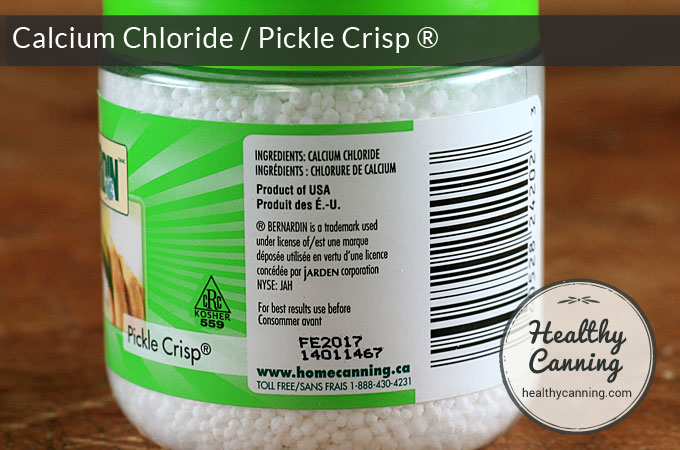
Pickle Crisp is pure Calcium Chloride with nothing else added.
Here’s the usage directions. Note that they are clear that just is just a crisper, and that you should in no way think that Pickle Crisp aids in proper preservation of your food products: responsibility for that is still on your shoulders!
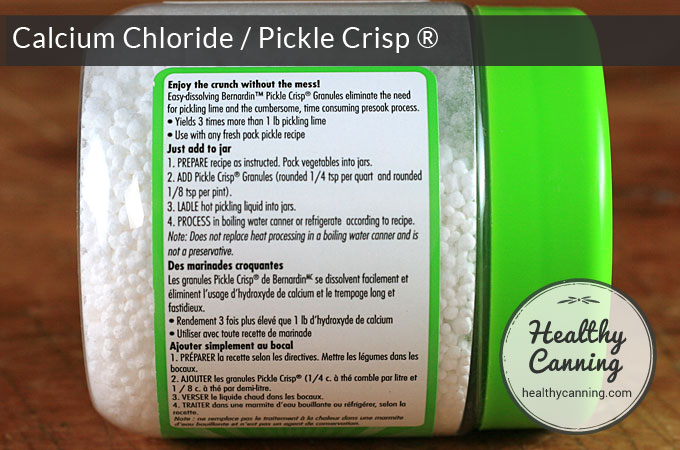
Pickle Crisp usage directions as per the label.
Calcium Chloride Nutrition
References


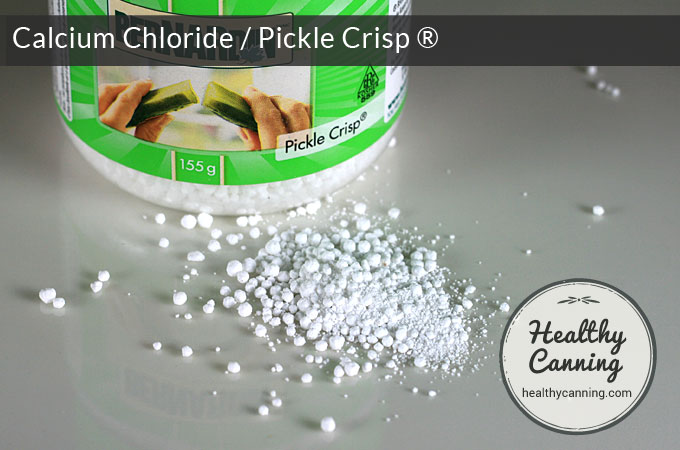
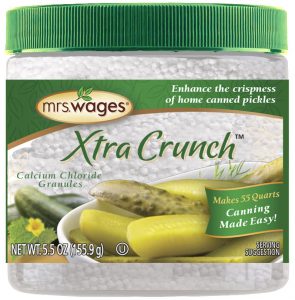
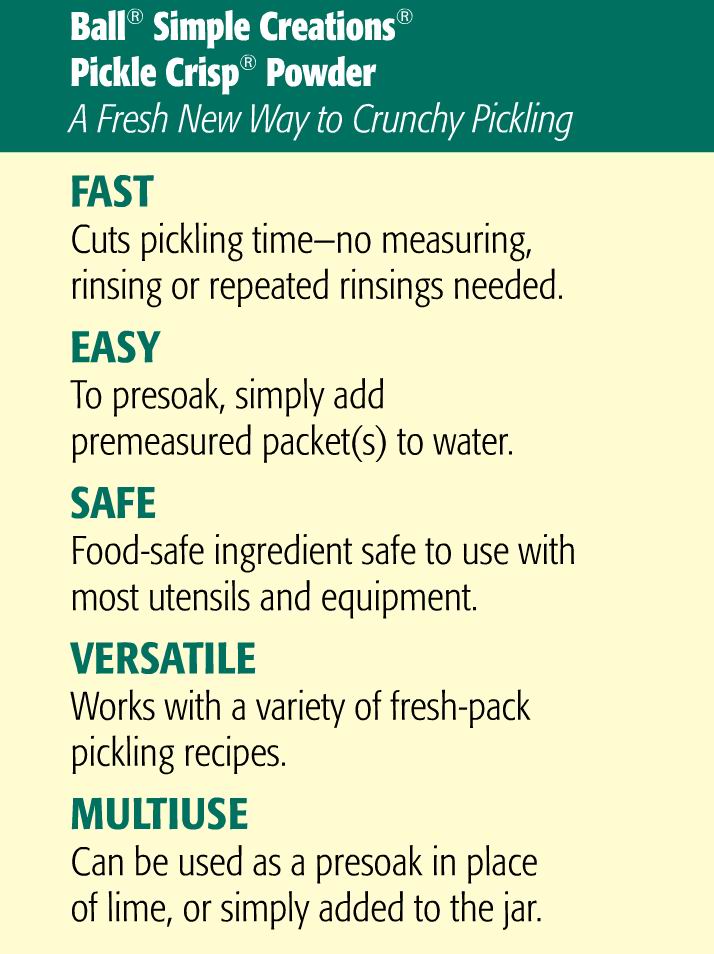
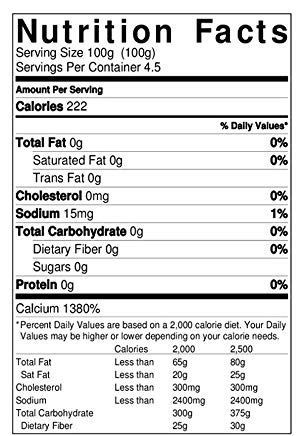

Pam
So confused and I can’t seem to find an answer anywhere. Does Pickle Crisp eliminate the need to “soak” pickles? Can I just make the liquid per the recipe, cut and put cucumbers in the jar, then add liquid and appropriate amount of Pickle Crisp for each jar?
Thanks in advance
Kim
That’s my understanding – that you add it to the jar rather than a pre-soak. My preferred method is still soaking in pickling lime. The question I have – and can’t find an answer to! – does Pickle Crisp help maintain the color of whatever’s being canned? You might test the pickling lime versus pickle crisp method by doing a few jars each way. No one seems to agree one method is better than the other. But – yeah – the non-rising way would be a time saver IF the pickle crisp really performs just as well as pickling lime. Good luck!
Edward Hoover
Just bought a jar of Ball Pickle Crisp Granules. Would have been nice if some genius would have included instructions on the container. Fortunately I have the skills to look up how to use the product.
karla
How much Pickle Crisp should I use when I pressure can my Kidney beans in quart jars? I notice on the purchased cans of kidney beans and all dry canned beans at the grocery store, that the commercial canners use Calcium Chloride. No one wants to open a can of mushy beans 🙂
Thanks
B
1/4tsp per jar directions
EricJM
Use the guidelines given in the article. (11/2 teaspoons per quart). That should work. Try one jar and if it taste too salty, you can lower it, but do not go below 1/4 teaspoon per quart.
Bill Cooley
I am making pickled okra today , do you think pickle crisp would make the okra more crunchy when done ?
Kevin Raleigh
I used pickle crisp when pickling okra in September 2020. It did make the okra more crunchy; however, I used 1/2 teaspoon for pint jars and it has made them taste more salty.
Sara
I’ve been wondering what else I could use this on to keep nice texture…here’s a site where they suggest 1/16 tsp: https://ask2.extension.org/kb/faq.php?id=643454
I haven’t tried it yet as I am new to canning and just found out about this product, but would like to!
Tom Jones
Yes, Pickle Crisp works great for okra! Use ⅛ teaspoon per pint, or ¼ tsp per quart.
EricJM
Yes, it would.
Barbara Culbert
I used Pickle Crisp Granules in my jars of sliced cucumbers with added garlic, as per recipe, and when I added the boiling brine liquid, it turned cucumbers and garlic blue??? Are they safe to eat ? Haven’t eaten yet.
Healthy Canning
The blue is the garlic, nothing to do with the pickle crisp. The following para is from So Easy to Preserve:
“Why did the garlic cloves in my pickles turn green or bluish green? This reaction may be due to iron, tin or aluminum in your cooking pot, water or water pipes reacting with the pigments in the garlic. Or, the garlic may naturally have more bluish pigment and it is more evident after pickling. Immature bulbs should be cured 2 to 4 weeks at 21 C (70 F). The pickles are safe to eat.”
Duane Matelski
has anybody used pickle crisp on dilly beans
Bea
Yes, they came out truly crisp! I make them every year
Marti
Great post! I just bought a jar of Pickle Crisp and there are no instructions on it so I was searching for amount to use when I next make pickles.
Sherry
I need a recipe for sweet pickles with pickle crisp granules
Vicky
I need recipe too. Surprised to not find it on their website.
Sherry2
My name is Sherry too & at first I thought I had posted this because I have been searching for a sweet pickle recipe also that specifically includes Pickle Crisp (Calcium Chloride). Why are they so hard to find?
Becki
Hi, I have a 30% calcium chloride solution i use in homemade yoghurt. From Green Living Australia. Would this be safe to use in place of pickle crisp?
https://www.greenlivingaustralia.com.au/calcium-chloride
Or would it be better to buy granules from a brewers supplies.
https://www.kegland.com.au/calcium-chloride-pickle-crisp-500g.html
Thanks
Becki
Brad
Either are fine. Assuming you have a food grade 30% by weight solution, 3g of powder, is replaced with 10g of liquid.
Becki
Thanks for that 🙂
Deryl Henson
How much Pickle Crisp is needed for a 30,000 ppm Calcium Chloride mixture?
Tony
If it is referring to the calcium chloride, it is 30g per litre. If referring just to the calcium or chloride. it will be more
Brad
I assume you mean in water? Using my high school chemistry class and googling the periodic table of elements…
Calcium Chloride, is CaCl2.
Has one calcium atom, two chlorine.
Atomic Weight of Calcium 40.08
Atomic Weight of Chlorine 35.45
CaCl2 is is 110.1
Water has, is H2O.
Has two hydrogen atoms, two oxygen.
Atomic Weights, 1.008, and 15.999
H2O is 18.015
30,000ppm, is 30,00 thousand parts per million,
Same as 30 parts per thousand,
or 3 parts per hundred (in molecules not in weight)
To turn to weight.
Multiply 3 by 110.1
and 100 by 18.01
This gives you, for any unit of weight, 330.3 Calcium Chloride units, and 1801 water units.
To normalise for water base:, divide both by 1801.
This now gives 1 part water to 0.1834 parts calcium chloride. (weight for weight)
That’s very strong, over 18% solution (bakers math).
Bakers math means start with 100% pure water, then add 18% that weight in Calcium Chloride. ( It adds up to 118% weight when done). The percentage of the total weight (out of 118) is 15.5%. But most pickle fermenters I know use bakers math, so by convention, it’s 18%.
But if for whatever reason you need 30,000ppm, you’d want distilled water, and pure calcium chloride.
Your local water supply might already have different metals in it. So the water will actually be more dense,. My tap water is 0.2% heavier than pure water. Most sources of Calcium Chloride, are also not pure, because it absorbs water from the air. Both of these things need to be tested to get an accurate concentration.
A hydrometer or refractory can check the density of the water. I don’t know how to check the water content of Calcium Chloride powder, but an actual chemist, or lab tech might.
Once Calcium Chloride dissolves into water, is separates into free floating ions, Calcium floating around, Chloride floating around. So that’s what you really have when you say 30,000 ppm, it is a simplification.
The trouble increases when you use tap water. The water can also have other sources of chlorine in it, many cities add chlorine, and the water can also have other sources of calcium. These can throw off everything. You need lab testing to really find out what the specific chlorine or calcium levels are.
Whatever you want 30,000 ppm for, and presumably there’s a reason, it will be due to some sort of effect. This then begs the question, are other contaminants going to also contribute to or hinder that effect. In the case of all but distilled water and hermetically sealed anhydrous calcium chloride, you might not know what that is.
Now if you have to ask what is 30,000 ppm, then and I mean this without any offense intended, then I’d imagine someone somehow put you up to it. Whoever it is, they probably have better context than you or I as to their needs and concerns. Best check with them, what they are achieve, with what constraints and materials, maybe even why, before deciding how to proceed.
Sorry to be so long winded, but I wanted you to understand the whole picture.
Katness
How much Pickle Crisp to add to jars of dried beans being pressure canned?
Healthy Canning
No one that I know has done any controlled experiments for home canning on adding pickle crisp to beans, or veg for that matter, being pressure canned. You will see it added commercially to canned items to help keep firmness. If someone did any experiments on it one day, it would make interesting reading to see if there were any firmness quality improvement, if so, how much, and how much calcium chloride per jar was used.
June Weatherman
I used pickle crisp in my canned Jalapeno Pepper rings and it kept the peppers crisp but they took on a strange taste. I put a small pinch into each pint jar then added the pepper rings and brine. Did I do something wrong?
Jean
Did you use the correct amount per pint or quart?
G. Farmer
I forgot to add it to my dill pickles when I canned. Can I add some when I open the jar later?
Healthy Canning
There won’t be any benefit to adding it later.
Bill
Why does Mrs Wages Xtra Crunch label say “Do Not Use with Mrs. Wages Refrigerator Pickle Mixes”? Is it Detrimental, or not needed?
I was told by Kent Precision Foods Customer Service that I could use Mrs Wages Quick Process Pickle Mix like a Refrigerator Pickle Mix (Refrigerate after instead of Boiling Water Bath). Can I, should I, use Xtra Crunch (or Pickle Crisp) with this procedure?
Healthy Canning
You would have to ask Mrs Wages why they give that advice. We’ve seen no information about whether Pickle Crisp helps with refrigerator pickles or not, so sadly have no advice to offer.
Barb
I have Pickle Crisp that is expired, but the date is a Best By date–not a Use By date. Granules etc look fine. Is this still safe to use?
Healthy Canning
It will be safe. Like salt, there shouldn’t ever really be an expiry date, because both are just minerals. But from experience we can say the best-before date might be there owing to things such as humidity, etc, which can cause the Pickle Crisp granules to clump, which makes it hard to measure.
Danniel C Richardson
I was told to use alum in my hot pepperssauce iss that so and if so how much do I use
Healthy Canning
Don’t use it, you were told wrongly.
Roxie Elliott
I would like to make spiced apple rings from cucumbers. My recipe calls for soaking them for 24 hours in pickling lime. How do I use the pickle crisp for this?
Healthy Canning
Not sure. You’d need to ask whoever it was who published the recipe you are using.
J
Have you tried the overnight soak in pickle crisp? If so how did you do it and were you happy with the outcome?
Janet L Ohanis
HI! How much Pickle Crisp and how much pickling salt do I use for one quart of hot peppers? I wanted to use just Pickle Crisp, but my brother (pepper grower,) insists I also use the pickling salt! LOL
Thanks for your advice!
Healthy Canning
Pickle Crisp: going by the ratio for Pickled Pepper Mix (Ball Blue Book, 37th edition, 2014, page 94), it would be 1/4 teaspoon pickle crisp per quart jar. There’s really no upper limit though that they’ve taught us, and Bernardin does tend to use it a bit more generously. I have a feeling they’d be inclined to do 1/2 teaspoon per quart jar. But there’s no studies either of them have released showing at what point adding more becomes pointless.
Salt is to taste, it’s not a preservative, just a seasoning in this context. So maybe 1 to 2 teaspoons per quart jar, depending on how salty you like things? Maybe 1 teaspoon if you are using Pickle Crisp — some people feel it enhances the salty taste of things, though for real salt lovers, that might not be enough of an enhancement.
laura
can I use pickle crisp in fridge pickles?
Healthy Canning
You could, yes, for sure!
Audrey
If I’ve already made my fridge pickles (cold brine, no processing) can I still add Pickle Crisp to the jars? I put them in jars a couple days ago. Thank you!
Healthy Canning
These are fridge pickles, right? You can give it a try!
Audrey Jestin
Yes, they are made with a cold brine, left to pickle in the fridge for about 5 days then packed into jars and stored in the fridge. Would I still use about 1/4 tsp pickle crisp per 500ml jar?
Pat
Can I add Pickle Crisp to my pints of Pickles using a brine made from Mrs Wages Bread and Butter Pickle Recipe or Mrs Wages Dill Pickle Recipe?
Healthy Canning
Absolutely.
Frank
I can chow-chow witch is made of cabbage onion peppers and green tomatoes and cooked in vinegar and water.my question is will pickle crisp work in canning the chow-chow
Healthy Canning
Pickle Crisp is designed to help veg stay crisp. You could certainly try some to see what you think.
Earlene Whited
My recipe calls for soaking the cucumbers for 3 hours in ice water after rinsing pickling lime out of them, then soak over night in the recipe brine. The next day I actually complete the process of draining off brine, heating to a boil, put cucumbers in jars add brine and process. Do I add the Pickle Crisp Granules when I put cucumbers in jars? Will that eliminate the step of needing to soak in ice water
Himalayan Chef
The “Pickle Crisp” chef is Mr Brine?
Carroll
I use a liquid form of pure calcium chloride in cheesemaking (to help firm cheese curds for hard cheeses like feta). Can the liquid form be used in canning pickles? If so, what is the amount needed per pint?
Healthy Canning
Hi Carroll, interesting question. I don’t have access to any primary sources I can cite on the use of the liquid form in home canning of pickles, so I’m going to have to refer you to certified Master Food Preservers who might.
There is a really helpful group who will try to help you fast here: https://www.facebook.com/UCCE-Master-Food-Preservers-of-El-Dorado-County-456649991034665/?fref=ts
Missy
Carroll, did you get an answer?
I have the same question.
No point buying yet another product if the one I already have does the job 🙂
matt k
Pickle crisp is nothing more then pool shock, it kills the enzymes in the cucumber that lead it to soften. Nothing dangerous about it.
DAVE
Matt
Pool shock is Calcium Hypochlorite or Sodium Hypochlorite. When wixed with water they give off Chlorine that is bleach. Not good to eat.
Calcium Chloride when mixed with water Give an acld and a base which tends to neutralize the ph of each
Will
This is not correct. Pool shock is hypochlorite (bleach), either sodium or calcium hypochlorite and the other is chloride. The chloride, (calcium chloride marketed as trademarked Pickle Crisp) is safe as a food additive.